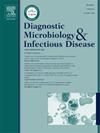植入物相关感染的抗菌素耐药性和生物膜形成:病原体分析和植入物敏感性
IF 1.8
4区 医学
Q3 INFECTIOUS DISEASES
Diagnostic microbiology and infectious disease
Pub Date : 2025-08-12
DOI:10.1016/j.diagmicrobio.2025.117061
引用次数: 0
摘要
由于抗菌素耐药性(AMR)的发展,医疗植入物相关感染正变得越来越危险。本研究探讨了感染性医疗植入物(IMI)的负担、生物膜生成的可能性以及植入物材料类型之间的关系。本研究共收集了135份医学植入物的感染性样本。采用基质辅助激光解吸电离飞行时间(MALDI-TOF)对分离菌进行鉴定。采用盘片扩散法和肉汤微量稀释法检测菌株的抗菌敏感性,采用微滴板法测定菌株的生物膜电位。致病菌以鲍曼不动杆菌最多(50例,占37%),其次为铜绿假单胞菌(42例,占31.1%)和大肠杆菌(21例,占15.6%)。抗菌药物敏感性分析显示MDR (n=89, 66%)、XDR (n=13, 7%)、PDR (n= 2.4, 4%)和敏感株(n=31,23%)。生物膜测定结果显示,强生物膜产生菌66株(49%),中等生物膜产生菌46株(33%),弱生物膜产生菌23株(18%)。最强的生物膜被发现在胫骨的互锁钉和矫形钉上。据报道,不锈钢植入物具有较高的生物膜电位。二元logistic回归显示鲍曼不动杆菌和不锈钢植入物是强生物膜形成的显著预测因子。同样,大肠杆菌和骨科钉与多药耐药独立相关。制毒肠杆菌亚种在巴基斯坦首次报道了植入物相关感染中的奥哈拉和Gemella溶血菌。这项研究强调了卫生专业人员和政策制定者需要解决有关植入物相关感染和替代治疗策略的问题。本文章由计算机程序翻译,如有差异,请以英文原文为准。
Antimicrobial resistance and biofilm formation in implants related infections: Pathogens profiling and implants susceptibility
Medical implant-associated infections are becoming increasingly hazardous because of the development of antimicrobial resistance (AMR). This study examined the burden of infectious medical implants (IMI), the possibility of biofilm generation, and the relationship between the type of implant material. A total of 135 infectious samples from medical implants were collected for this study. Matrix-assisted laser desorption Ionization time-of-flight (MALDI-TOF) was used to identify bacterial isolates. Disk diffusion and broth microdilution were used to test antimicrobial susceptibility, and biofilm potential was determined using a microtitre plate assay. The most prevalent pathogen was Acinetobacter baumannii (n=50, 37%), followed by Pseudomonas aeruginosa (n=42, 31.1%) and Escherichia coli (n=21, 15.6%). Antimicrobial susceptibility profiling showed MDR (n=89, 66%), XDR (n=13, 7%), PDR (n=2, 4%), and sensitive isolates (n=31,23%). The biofilm assay showed 66 (49%) strong, 46 (33%) moderate, and 23 (18%) weak biofilm producers, respectively. The strongest biofilms were found on the interlocking nails of the tibia and orthopaedic staples. A higher biofilm potential has been reported for stainless-steel implants. Binary logistic regression revealed that A. baumannii and stainless steel implants were significant predictors of strong biofilm formation. Similarly, E. coli and orthopedic staples were independently associated with multidrug resistance. Enterobacter hormaechie subsp. Oharae and Gemella haemolysans were reported first time in Pakistan among implants related infections. This study highlights the need for health professionals and policymakers to address concerns regarding implant-associated infections and alternative therapeutic strategies.
求助全文
通过发布文献求助,成功后即可免费获取论文全文。
去求助
来源期刊
CiteScore
5.30
自引率
3.40%
发文量
149
审稿时长
56 days
期刊介绍:
Diagnostic Microbiology and Infectious Disease keeps you informed of the latest developments in clinical microbiology and the diagnosis and treatment of infectious diseases. Packed with rigorously peer-reviewed articles and studies in bacteriology, immunology, immunoserology, infectious diseases, mycology, parasitology, and virology, the journal examines new procedures, unusual cases, controversial issues, and important new literature. Diagnostic Microbiology and Infectious Disease distinguished independent editorial board, consisting of experts from many medical specialties, ensures you extensive and authoritative coverage.

 求助内容:
求助内容: 应助结果提醒方式:
应助结果提醒方式:


